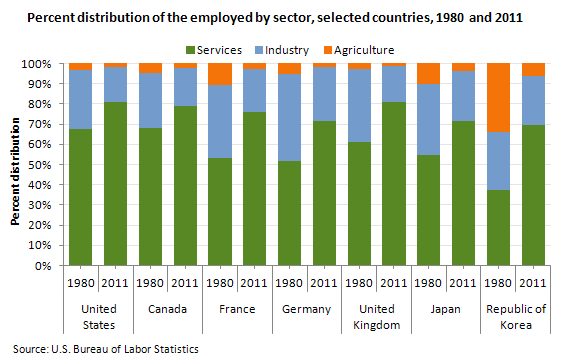July 6, 2012 (The Editor’s Desk is updated each business day.)
Sector employment shifts around the world
The United States and other industrialized nations have experienced an employment shift away from the goods-producing sector and toward the service-providing sector in recent decades.

[Chart data]
In 1980, agriculture accounted for 3.4 percent of employment in the United States, and that share had fallen to 1.6 percent by 2011. Germany, Canada, and the United Kingdom had similarly low shares of their total employment in agriculture in 1980, and all three countries saw those shares decline by 2011. The Republic of Korea (commonly called South Korea), France, and Japan had larger employment shares in agriculture in 1980; all three countries saw those shares drop sharply by 2011.
Employment in industry—which includes manufacturing, mining, and construction—declined as a share of total employment in all the countries shown in the chart. At the same time, services accounted for a larger share of employment in each country in 2011 than in 1980. About 8 in 10 workers in the United States, Canada, the United Kingdom, and France were employed in services in 2011. About 7 in 10 workers in Germany, Japan, and South Korea were employed in services in 2011.
These data are from the International Labor Comparisons program. For more information, see "International Comparisons of Annual Labor Force Statistics, Adjusted to U.S. Concepts, 16 Countries, 1970-2011," (HTML) (PDF). Data for Germany in 1980 include only West Germany. Agriculture includes agriculture, forestry, hunting, and fishing. Services include transportation, communication, public utilities, trade, finance, public administration, private household services, and miscellaneous services.
Related TED articles
Employment |
Industry Studies |
International Comparisons |
Manufacturing
Of interest
Spotlight on Statistics: National Hispanic Heritage Month
In this Spotlight, we take a look at the Hispanic labor force—including labor force participation, employment and unemployment, educational attainment, geographic location, country of birth, earnings, consumer expenditures, time use, workplace injuries, and employment projections.
.
Read more »
